-
NBS Tasks
Browse topics
- Monetary policy
- Financial market supervision
- Financial stability
- Banknotes and coins
- Payments
- Statistics
- Research
- Legislation
-
Publications
- Activity Report of the NBS Innovation Hub Annual Report Economic and Monetary Developments Financial Stability Report Investment Policy Statement of the National Bank of Slovakia Macroprudential Commentary Policy Briefs
- Report on the Activities of the Financial Market Supervision Unit Research Papers: Working and Occasional Papers (WP/OP) Statistical Bulletin Structural Challenges Other publications Sign up for your email notifications about publications
- About the Bank
- Media
- Frequently asked questions
-
For the public
Browse topics
- About the Bank
- Exchange rates and interest rates
- Banknotes and coins
- Payments
- Financial stability
- Financial market supervision
- Statistics
- Legislation
-
Publications
- Activity Report of the NBS Innovation Hub Annual Report Economic and Monetary Developments Financial Stability Report Macroprudential Commentary
- Report on the Activities of the Financial Market Supervision Unit Statistical Bulletin Other publications Sign up for your email notifications about publications
- Frequently asked questions
- Media
- Careers
- Contact
Set of commemorative coins with the motifs of Slovak banknotes
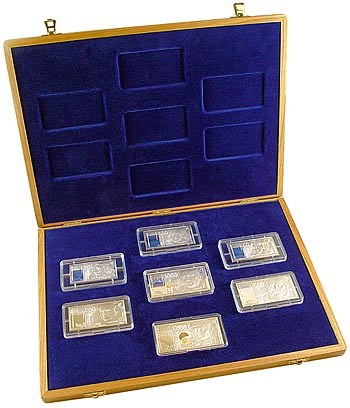
On 1st January 1993, the day of the origin of the independent Slovak Republic, the National Bank of Slovakia was established and began to fulfill the roles of the central bank. One of the most urgent tasks was to prepare the new Slovak currency, the Slovak crown, in a very short time. The first banknote, of nominal value fifty crowns, was put into circulation on 30th August 1993, and the banknotes with other face values gradually followed.
All seven Slovak banknotes were designed by the academic painter Jozef Bubák. Their artistic conception is based on a combination of modern and traditional banknote design combined with a high level of technical protection of the banknotes against counterfeiting. The obverse sides bear portraits of the most important personalities, who were active in the territory of present-day Slovakia during more than a thousand years of history and substantially contributed to the formation of the Slovak nation. The reverse sides bear places and motifs connected with their lives and activities. An exception is the hundred crown note with the motif of the Madonna from the workshop of Master Paul of Levoča.
Designs of the coins
20 Sk
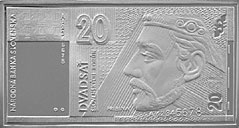
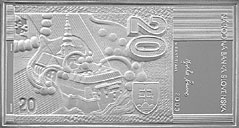
-
Coin description
Obverse:
The obverse bears a portrait of the first known Slavonic ruler in the territory of Slovakia, Prince Pribina (about 800-861). The Principality of Nitra probably originated around the year 800, in an area roughly corresponding to that of present-day Slovakia. Pribina had a church built at Nitra, the capital of the principality. It is the first known Christian church in Slovakia. About 833, Prince Mojmír of the neighbouring Principality of Moravia expelled Pribina and added Nitra to his dominions. In 838-839, Pribina acquired property around Lake Balaton as a fief of the Frankish Empire, created an extensive principality and did much to spread Christianity in the area.
Reverse:
Nitra Castle is depicted on the reverse. It bears witness to the rich past of the town of Nitra, from early times a uniquely important strategic place and the natural centre of the region. The design repeatedly overlaps with part of a 9th century bead necklace with a bronze moon-shaped pendant from the archaeological site of Nitra-Lupka.
50 Sk
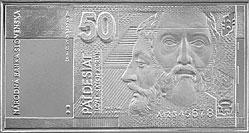
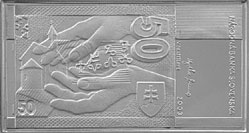
-
Coin description
Obverse:
The obverse side is devoted to the bringers of Christianity to the Slavs: Saints Constantine – Cyril (827-869) and Methodius (814-885). The Byzantine Emperor Michael III sent them to Great Moravia at the request of Prince Rastislav, who desired to establish a separate ecclesiastical organization in his principality and to ensure the spreading of Christianity in a language comprehensible to the people. Constantine had already created a Slavonic alphabet and translated the most essential liturgical texts into Old Slavonic before their arrival. The two brothers developed multifaceted activities in the fields of religious teaching, organization and culture. They established a school for training priests, which became a centre of culture, education and literature. In 868, they gained the approval of Pope Hadrian II for the Slavonic liturgy, and the Old Slavonic language was placed on the same level as the established cultural languages: Latin, Greek and Hebrew.
Reverse:
The reverse side bears the motif of two hands with the first seven letters of the Old Slavonic Glagolitic alphabet between them as a symbol of the gift of the saints to the Old Slavs and the silhouette of the medieval church at Dražovce as a symbol of early Christianity in our territory.
100 Sk
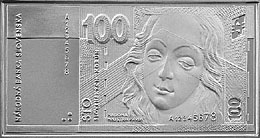
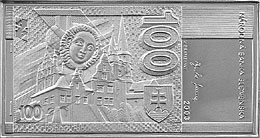
-
Coin description
Obverse:
A portrait of the Madonna based on a Gothic sculpture from the Altar of the Nativity in the parish church of St. James at Levoča appears on the obverse. The altar was made by Master Paul of Levoča (about 1470-1540), the most important representative of Late Gothic sculpture in Slovakia. Master Paul established and headed his own woodcarving workshop at Levoča, and employed several important carvers. The workshop produced sculptures found in various churches in eastern Slovakia and at Banská Bystrica. His most important work is the main altar of the parish church of St. James at Levoča. With a height of 18.62 m, it is the tallest original Gothic winged-altar in the world.Reverse:
The dominant architectural features of the town of Levoča – the Gothic church of St. James and the Renaissance town hall are depicted on the reverse. They overlap with a vault of the sacristy of the old Franciscan Church of Levoča.
200 Sk
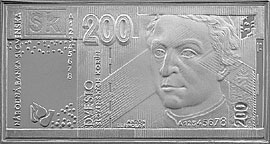
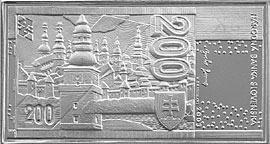
-
Coin description
Obverse:
The motif on the obverse side is a portrait of the priest and linguist Anton Bernolák (1762-1813), one of the leading representatives of the Slovak national revival and a supporter of the Enlightenment. He gained a place in Slovak history as the first codifier of standard written Slovak – the so-called “Bernolakovčina” based on cultured western Slovak. Although Bernolák’s version was not accepted as the standard written language, it represents an important milestone on the route to the formation of the modern Slovak nation. He was the instigator of the literary publication society, the Slovenské učene tovarišstvo (Slovak Learned Society), which distributed educational books in the new codified Slovak among the Slovak public, and of the movement carried on by his successors, which lasted three generations.
Reverse:
The reverse bears a view of Trnava in the 18th century, with a present-day view of the symbol of the town – the Renaissance town tower – placed in the foreground.
500 Sk
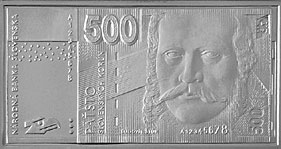
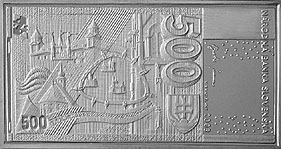
-
Coin description
Obverse:
The politician and linguist Ľudovít Štúr (1815-1856), one of the most important representatives of the Slovak nation in the 19th century appears on the obverse. He was the leading personality among the nationally conscious youth, who later played an important part in applying the programme of Slovak national identity under his leadership. In 1843, together with Michal Miloslav Hodža and Jozef Miloslav Hurban, he established a new standard written language for the Slovaks based on central Slovak dialects. It became an integrating factor in the creation of modern Slovak national and civil society. In 1848, he presided over an assembly of Slovak patriots at Liptovský Svätý Mikuláš, where the Demands of the Slovak Nation were declared. The Slovaks demanded federalization and democratization of the Kingdom of Hungary and autonomy for Slovakia. He was one of the organizers and participants in the Slovak Uprising of 1848-1849, the first armed campaign by the Slovaks for recognition of their national identity, and for civil rights and freedoms.Reverse:
The reverse bears an image of Bratislava Castle with the Baroque church of St. Nicholas and part of the tower of the Gothic Klarisky Church. The oldest plan of Bratislava – a 15th century wood engraving from the Chronica Picta – is placed in the centre.
1 000 Sk
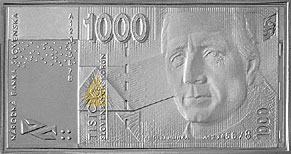
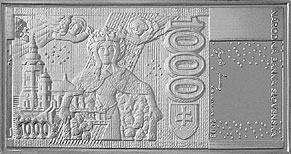
-
Coin description
Obverse:
A portrait of the Christian politician Andrej Hlinka (1864-1938) is placed on the obverse. He was an important personality in modern Slovak history, who significantly influenced the development of national consciousness and socio-political movement in Slovakia. As a member of the leadership of the Slovak National Party and from 1913 as leader of the Slovak People’s Party, he severely criticized the social and nationality policy of the Hungarian government. In the revolutionary months of 1918, he supported the origin of a Czechoslovak state and secession from the Austro-Hungarian Monarchy. However, after the formation of the Czechoslovak Republic he criticized the disappearance of Slovak representative institutions and the failure to solve the constitutional position of Slovakia in the joint republic. The demand for Slovak autonomy had the first place in the party programmes he promoted as a member of parliament. Thanks to its national and Christian orientation, his party became the largest in Slovakia.
Reverse:
The central motif on the reverse is the Madonna Protector from a medieval wall painting in the Roman Catholic Church at Liptovské Sliače near Ruzomberok. A picture of the Roman Catholic church of St. Andrew at Ružomberok and the mausoleum of A. Hlinka in the same town fill the left part.
5 000 Sk
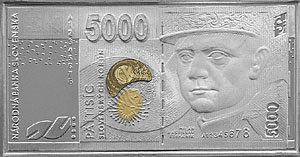
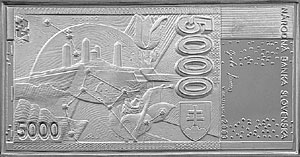
-
Coin description
Obverse:
The obverse is devoted to Milan Rastislav Štefánik (1880-1919), politician, diplomat, astronomer and one of the creators of the Czechoslovak Republic. He worked as an astronomer in France and after the outbreak of the First World War, he became a pilot in the French Army, in which he achieved the rank of general. He was one of the leading representatives of the Czecho-Slovak exile struggle for the break up of Austria-Hungary and the creation of an independent state for the Czechs and Slovaks. In 1915, he began to cooperate with Tomáš Garrigue Masaryk and Edvard Beneš. They jointly established the Czecho-Slovak National Council in Paris. When the independent Czechoslovak Republic was established in October 1918, Štefánik became minister for war in the first Czechoslovak government. In January 1919, he returned to Paris, where he participated in the peace talks. Upon his return to Slovakia, he died tragically in a plane crash. Štefánik’s portrait is supplemented by artistic elements depicting the Sun, a half-Moon and a comet, which recall that he devoted a significant part of his life to research and observation in astronomy.
Reverse:
The monument over the grave of Štefánik on Bradlo hill is the main design on the reverse. It overlaps with depictions of part of the Great Bear constellation and two pasqueflowers.
Parameters of the coins
| Nominal value | Dimensions (mm) | Ag blank Weight (g) | Au blank Weight (g) | Coin Weight (g) |
| 20 Sk | 27.1 x 50.6 | 24.48 | – | 24.48 |
| 50 Sk | 28.2 x 52.8 | 26.63 | – | 26.63 |
| 100 Sk | 29.3 x 55.0 | 28.87 | – | 28.87 |
| 200 Sk | 30.4 x 57.2 | 31.21 | – | 31.21 |
| 500 Sk | 31.5 x 59.4 | 33.63 | – | 33.63 |
| 1000 Sk | 32.6 x 61.6 | 43.91 | 0.280 | 44.190 |
| 5000 Sk | 33.4 x 63.8 | 46.65 | 0.594 0.370 | 47.614 |
| Authors of relief transcription of the banknotes: | Štefan Novotný (obverse), Mária Podlaufová (reverse) |
| Gross weight of the metal in the set: | 235.38 g 1.244 g |
| Purity: | Ag 925 Au 999 |
| Net weight of precious metals in the set: | 217.7265 g Ag (7 oz Ag) 1.244 g Au (1/25 oz Au) |
| Edge: | smooth |
| Producer: | Kremnica Mint |
| Issuing volume: | 6,000 sets |
| Quality: | proof |
| Issuing date: | 19. December 2003 |